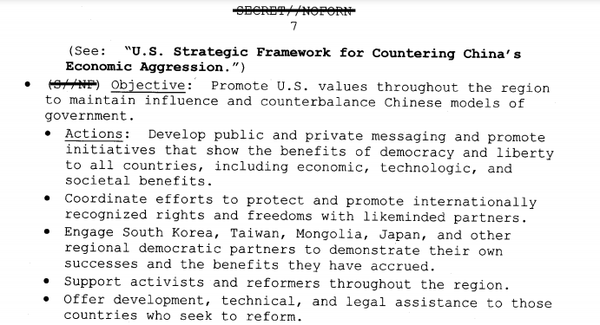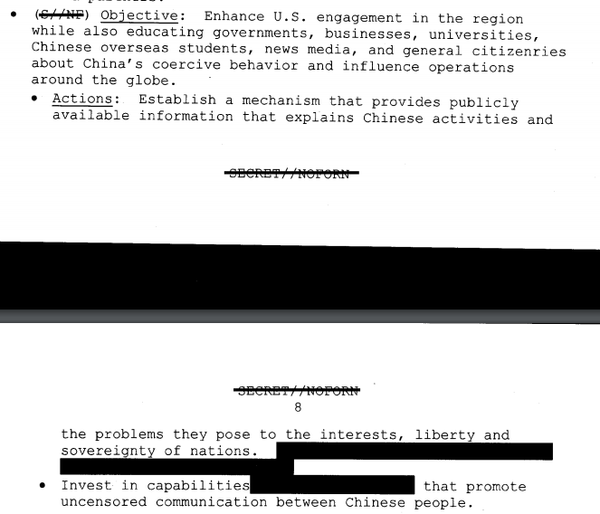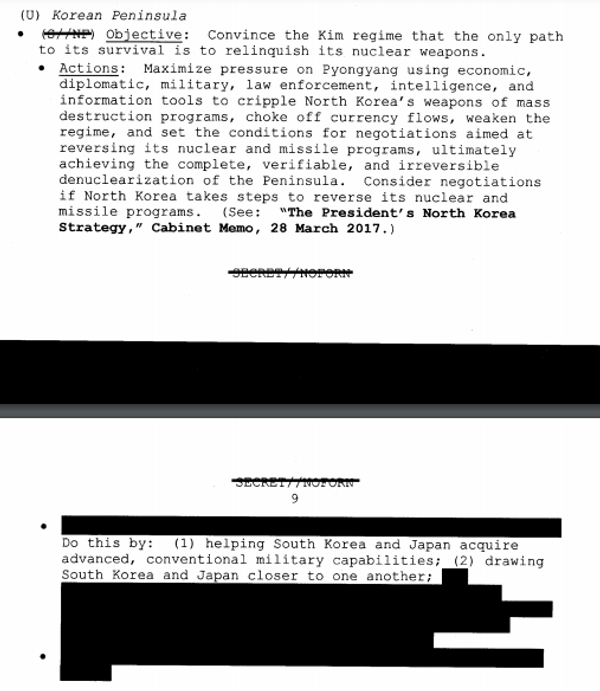A key secret strategy document recently declassified by the Trump administration has revealed the private thinking of the National Security Council about the US approach to maintaining dominance in the Indo-Pacific region. Interestingly, the document clearly states it should not be declassified before December 31, 2042, and it contains only minor redactions.
Titled the “US Strategic Framework for the Indo-Pacific,” the February 2018 document by the National Security Council is distinctly different from the June 2019 Indo-Pacific Strategy Report, which was released publicly by the Pentagon.
In a statement issued with the declassified document, the outgoing White House national security adviser, Robert O’Brien, noted that it has “provided overarching strategic guidance for implementing the 2017 National Security Strategy within the world’s most populous and economically dynamic region.”
A comparison of the private framework, created just weeks after the National Security Strategy, and the public report published a year and a half later, shows inconsistencies between publicly stated and privately acknowledged priorities by the Trump administration.
Russia: Malign Actor or Marginal Player?
Both documents prioritize China as the primary threat to US hegemony in the region, with the framework noting that “China will circumvent international rules and norms to gain an advantage.”
But while the public strategy report lists Russia as a “revitalized malign actor” that “seeks to advance Moscow's strategic interests while undermining US leadership and the rules-based international order,” in private, NSC members are telling each other that “Russia will remain a marginal player relative to the United States, China, and India,” according to the framework document.
Indeed, the framework lists just three regional national security challenges for the US:
- How to maintain US strategic primacy in the Indo-Pacific region and promote a liberal economic order while preventing China from establishing new, illiberal spheres of influence, and cultivating areas of cooperation to promote regional peace and prosperity?
- How to ensure North Korea does not threaten the United States and its allies, accounting for both the acute present danger and the potential for future changes in the level and type of the threat posed by North Korea?
- How to advance US global economic leadership while promoting fair and reciprocal trade?
Given the frankness of the declassified framework, the few omissions are conspicuous.
For example, under the section outlining the objective to “strengthen the capabilities and will of Japan, the Republic of Korea, and Australia to contribute to the end states of this strategy,” the first action on the list is redacted. Further redactions appear in the Actions section, under the objective of “acclerat[ing] India’s rise” and under the section on “strengthening the capacity of emerging partners in South Asia.”
Defending South China Sea and Taiwan
In the framework’s largest section, on countering China, much of the expected posturing against Chinese military capabilities seen elsewhere is laid out, including an ambitious goal to deny China its “sustained air and sea dominance inside the ‘first island chain’ in a conflict; defending the first-island-chain nations, including Taiwan;” and dominating all domains outside the first island chain.” The final part of that bullet point is redacted.

The “first island chain” is a Chinese term referring to the string of islands just off the eastern coast of Asia, stretching from the Kamchatka Peninsula in the north to the Maylay Peninsula in the south and including Taiwan and the South China Sea, over both of which Beijing has made territorial claims contested by Washington and other regional allies. China’s own military goals include establishing military dominance over this area and pushing beyond it by denying US forces the ability to operate safely there.
Over the last few years, the Trump administration has funneled billions of dollars in weapons to Taiwan, although the US normalization of relations with Beijing includes an agreement with the position of Beijing that Taiwan is a part of mainland China. The US also stepped up its activities in the South China Sea, holding vast military drills and “freedom of navigation operations” that flout the disputed Chinese territorial claims.
Supporting Chinese Dissidents
Not often seen, however, is a program for undermining Chinese authority by funding and otherwise enabling dissidents.
One objective, “promote US values throughout the region to maintain influence and counterbalance Chinese models of government” calls for the US to “support activists and reformers throughout the region.” Later, in a section on “educating” people, institutions and governments about ‘China’s coercive behavior,” the framework advises the US to “invest in capabilities [redacted] that promote uncensored communication between Chinese people.”


This document was written in 2018, before massive protests in Hong Kong saw the imposition of Beijing's new National Security Law in June 2020. Sputnik reported during the protests on allegations that key groups and leaders of the movement were said to have had extensive contacts and backing from the United States, via the CIA-backed National Endowment for Democracy. Just days after the new security law was passed banning such financial support, the largest and most influential dissident group in Hong Kong, Demosisto, almost folded its official online presence.
US-China Conflict Between ‘Political and Economic Systems’
A secret framework suggests that “strategic competition between the United States and China will persist, owing to the divergent nature and goals of our political and economic systems.”
The National Security Strategy on which the framework is based says, however, that “great power competition” with China has returned because Beijing “seeks to displace the United States in the Indo-Pacific region, expand the reaches of its state-driven economic model, and reorder the region in its favor.” That document was issued by the White House in December 2017 and was primarily written by the then-deputy national security adviser, Nadia Schadlow, at the behest of the NSC, the government body that wrote the secret framework.
In public, the Pentagon was saying China is a threat to US interests because of the choices of its leadership, but in private, the NSC was frankly stating the conflict was, cold war-style, a showdown between capitalism and socialism that will continue until one or the other is defeated.
That conclusion complements another revelation from November 2020, after the US State Department published a blueprint for a decades-long struggle to isolate and undermine China, that Sputnik reported at the time bore a strong similarity to the “Kennan Long Telegram” that influenced US policy towards the Soviet Union during the Cold War. The document not only called to curb Beijing's attempts to win friends abroad, but also prioritized shifting US institutions, including education, culture, and the civil service, toward inculcating in the US populace and institutions reasons why China must be considered an enemy.
DPRK
Most of the section on relations with the Democratic People’s Republic of Korea (DPRK) is redacted, but part of a bullet point in a section about convincing Pyongyang to give up its nuclear weapons says “[redacted] Do this by: (1) helping South Korea and Japan acquire advanced, conventional military capabilities; (2) drawing South Korea and Japan closer to one another; [redacted].”
The time in which the framework was written is key, as, in February 2018, the US relationship with the DPRK was notably hostile. Just months earlier, US President Donald Trump threatened the socialist country with “fire and fury” if it didn’t end its ballistic missile program and thermonuclear weapon tests.

While Pyongyang agreed to a unilateral moratorium on both by the time the Indo-Pacific Framework was written, the historic peace talks with Seoul and denuclearization talks with Washington that followed later in 2018 and 2019 had not yet begun. In those talks, North Korean leader Kim Jong Un displayed a willingness to take major steps toward ending those weapons programs, in exchange for the US ending its strangling economic sanctions on the country. The Trump administration refused and the talks quickly stalled.
‘Dissonance’ Over India
The position of India in the two documents is different as well, as, in the public strategy report, India is grouped with smaller regional nations with which the US needs to expand cooperation. However, in the secret 2018 framework, India features much more prominently.
According to The Diplomat, the secret framework shows a “glaring” dissonance with long-standing national strategy outlined by the administration of Indian Prime Minister Narendra Modi, who prefers a “multipolar Asia in a multipolar world” instead of merely existing as a gear in Washington’s plan for its own regional dominance.
The final section, on Southeast Asia and the Pacific Islands, is heavily redacted, including objectives to promote and support “Burma’s transition to democracy.”




